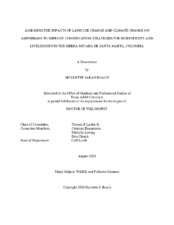Assessing the Impacts of Land Use Change and Climate Change on Amphibians to Improve Conservation Strategies for Biodiversity and Livelihoods in the Sierra Nevada De Santa Marta, Colombia
Abstract
Land use and climate change are major anthropogenic threats to biodiversity. In the
tropics, over 70% of land is in some form of agricultural matrix. Amphibians are the most
threatened vertebrate class. Colombia, a megadiverse country, is second in amphibian species
and the world’s third largest coffee producer. Here, montane regions are impacted by agriculture
and contain high levels of biodiversity and endemism. The Sierra Nevada de Santa Marta
(SNSM) has high amphibian diversity and endemism and is the fourth largest coffee growing
region in Colombia, making it a globally important biological and cultural region. The SNSM
rises from the sea to 5,775 m in just 42 km, with overlap between coffee and amphibian habitat
between 600 – 1,800 m. I examined three important themes related to amphibian conservation; 1)
land cover impacts on amphibian community structure; 2) vulnerability of amphibian species to
climate change; and 3) coffee farming community (cafeteros) perceptions and knowledge of
biodiversity, climate change, and sustainability. We conducted amphibian visual encounter
surveys from September 2017 to July 2018 at 35 transects across five major land cover types:
forest, ecotone, páramo, pasture, and shade coffee. We modeled scenarios of climate change
using multiple global climate models and two emissions scenarios and also conducted focal
group surveys with five coffee growing communities in 2017 and 2018. Nineteen species of
amphibians were recorded on surveys including 16 endemic. Land cover was the main
determinant of amphibian community structure. The climate vulnerability assessment identified
seven high priority species. Finally, we found that while coffee farmers have an inherent
appreciation for the landscape and conservation; they require economic support to achieve
sustainability goals. Regional conservation should be collaborative and include private landowners, non-governmental organizations, government agencies, and academics. Actions
should prioritize protecting extant natural habitat, restoring degraded habitats, increasing the
heterogeneity of production systems, and improving landscape connectivity and watershed
health. Preserving and restoring forest and ecotone land cover types will help retain amphibian
habitat, improve watershed quality, and reduce climate impacts. Local communities must be
involved in conservation action, to increase equitable and sustainability practices that can
contribute to long-lasting positive conservation achievements in the SNSM.
Citation
Roach, Nicolette Sarah (2020). Assessing the Impacts of Land Use Change and Climate Change on Amphibians to Improve Conservation Strategies for Biodiversity and Livelihoods in the Sierra Nevada De Santa Marta, Colombia. Doctoral dissertation, Texas A&M University. Available electronically from https : / /hdl .handle .net /1969 .1 /192612.


